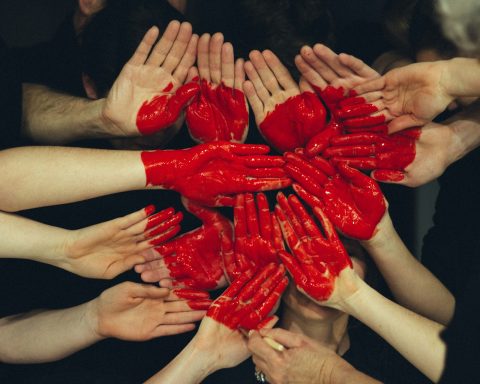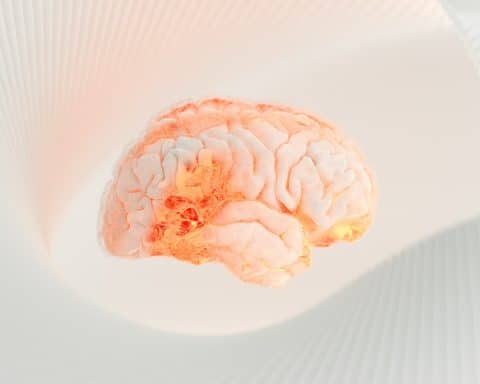 Paul McNamara is a Principal GP in Glasgow and honorary clinical lecturer at the University of Glasgow
Paul McNamara is a Principal GP in Glasgow and honorary clinical lecturer at the University of Glasgow
Ella Butterworth is a final year medical student at the University of Glasgow
‘There’s a story I need to tell. It’s been bubbling inside me, like gas trapped in a bottle, for years, trying to escape. Trapped. The cracks are showing now. They’re small, infinitesimal. The hard edges are splitting.
Crack.
Fags.
Booze.’
These are the words of the highly educated patient in front of me.*
‘Education. Oh how education saved me! I look back from where I am now, to that child holding it all together, like plasters on a deep wound. Useless and temporary. It all falls apart in the end. My brain was screaming then; save me, I’m drowning here. But I kept on going. Running on empty.
She died. My mum. A long, slow, horrible and horrendous death. One that lasted more than 10 years. I watched her. I carried her. To the hospital. Up the stairs. The seven stories up to her council flat; one giant concrete high rise coffin in an urban graveyard. Tombstones everywhere. I carried her to her chair, the soiled one burnt with fags. Then finally, to her ultimate place in the ground.
She carried me, then I carried her. Feels like I still do, even though she left many years ago. A heavy weight remains deep inside. It felt so unfair at the time. My beautiful, funny, life loving mother got sick.
But not conventional sick. Not the sick where people send flowers and grapes. We got the ‘we don’t want to know’ kinda sick. She radiated love. It surrounded her and enveloped me. Then came the clouds. Dark and full, ready to burst. She changed then.
It all changed. She withered. Her glow faded and we were left with a shadow. A glimpse. Not even a glimmer of what she was. Torment and turmoil followed. Alcohol. Oh how the drinks flowed. But there was no party in her glass. Suicidality and destruction entered our lives.
I tried to carry the weight but it was too heavy and she fell. I dropped her. Broken bones and smashed facades. I couldn’t save her, but here I am! Bursting to spill. I let her pain rot inside me decades after she left.’
Trauma and the body’s reaction to it can lead to many different physical manifestations that can be difficult to diagnose and treat.
My patient was asking for help. At last! It had taken several months for him to open up. Grief comes in many forms; I’ve seen that many times. My patients’ trauma came and stayed buried. But now the trauma was manifesting in physical symptoms. He was boiling over; his skin that had beads of sweat was ready to pour. The bubble had burst and he now started having seizures.
Trauma and the body’s reaction to it can lead to many different physical manifestations that can be difficult to diagnose and treat.
Non-epileptic seizures are a group of seizure types that are not related to electrical disturbance in the brain.1 Some non-epileptic seizures are caused by extreme psychological or emotional responses to trauma, where following a traumatic event the patient may dissociate or have an unconscious trigger that causes a seizure, also known as a psychogenic non-epileptic seizure (PNES).2 These events can occur up to several times a day and be life-altering for a patient, significantly reducing their quality of life and leaving them isolated from friends and family as they fear having an event while outside or in the presence of others.
One study showed an incidence rate of 4.9 per 100,000 patients annually, with the incidence varying largely depending on age demographics, gender and history of adverse events.3,4 The prevalence of PNES is harder to ascertain as many patients may disengage from medical services after their diagnosis, but is estimated to be in the range of 2-33 per 100,000 patients.5
There is no one conclusive factor for the development of PNES and they seem to form from several pathopsychological mechanisms.4 The most significant factors for developing PNES are experiencing adverse childhood events or trauma during adulthood – any number of events can be linked to these including sexual or physical abuse, bereavement, financial loss or parental conflict during childhood.7,1 Psychiatric co-morbidities including anxiety, depression and post-traumatic stress disorders are also seen in patients with PNES, and the conditions may all go hand in hand to worsen outcomes for these patients.5 These factors are then influenced by stressors and events which may trigger memories for the patient, causing ‘flashbacks’, which then leads to the mind shutting down as a way of protecting itself.
Psychological trauma and its association with multimorbidity is still poorly understood despite a clear link to common conditions seen in general practice including PNES, fibromyalgia and other forms of chronic pain. PTSD UK describes how 10 to 50% of people with PTSD also report living with chronic pain, and how those with a background of trauma will be impacted more when experiencing forms of chronic pain.8
Multimorbidity, defined as the presence of 2 or more chronic health conditions in a patient, is becoming more common worldwide due to a combination of factors including population ageing, environmental issues and adverse events. Half of people over 60 years of age now have multimorbidity and are underrepresented in randomised control trial studies, which proves a challenge to all health sectors to manage.9 Patients with multimorbidity are at higher risk of adverse health events as they have complex medical care needs. These may result in polypharmacy and poor care delivery due to the complexity of patients’ management plans. It is associated with premature death and poor quality of life. Although there are complex relationships between multimorbidity, biologic and genetic factors and environmental impacts, there is strong evidence that negative socioeconomic and psychosocial events can greatly increase the risk of a person developing multimorbidity.10
A systematic review and meta-analysis of all studies that looked at ACEs and multimorbidity globally showed a marked significance in exposure to ACEs resulting in multimorbidity in adulthood.
Traumatic experiences are especially impactful during childhood and adolescence and have been shown to greatly increase the risk of multimorbidity in adulthood. So called Adverse Childhood Events (ACEs) include physical, sexual and emotional maltreatment and general household problems including unstable financial situations, divorce, substance misuse and parental incarceration.11 A variety of health conditions can develop following ACEs, including psychological conditions such as anxiety and depression as well as chronic conditions including PNES and chronic pain. A systematic review and meta-analysis of all studies that looked at ACEs and multimorbidity globally showed a marked significance in exposure to ACEs resulting in multimorbidity in adulthood.12
Multimorbidity, chronic health conditions and their link to adversity is a challenge globally for all healthcare practitioners to overcome. By acknowledging the links between trauma and its effects on the body and the mind, we as practitioners can better understand our patients and plan appropriate management for them. Current recommendations include talking about and overcoming past traumatic experiences through cognitive behavioural therapy.13 Identifying the mind as a source of the body’s pain can help a patient make great strides towards taking control of their health and reducing the impact chronic illness has on their day to day lives. We should take every step to facilitate this road to recovery with our patients by informing them of the link between mental health and physical symptoms, the benefits of CBT and exercise and helping them open up about previous traumatic experiences. Similarly identifying patients who have multimorbidity and taking an individual-centred approach to their treatment and overall health profile will allow clinicians to better target their care. Sometimes as doctors, we see a troubled patient and our heart sinks. Through my patients, I have seen that trauma and grief can take people to places they never thought they’d go. But where grief lies, love and compassion can always grow. My patient, like many, might be damaged, but he is definitely not broken; fortunately, with the right support, my patients’ rock bottom became the foundation for which he could rebuild his life.
*Authors’ note: The above is based on a fictional patient interaction.
References
1. Huff JS, Lui F, Murr NI. Psychogenic Nonepileptic Seizures. [Updated 2024 Feb 25]. In: StatPearls [Internet]. Treasure Island (FL): StatPearls Publishing; 2024 Jan-. Available from: https://www.ncbi.nlm.nih.gov/books/NBK441871/ [accessed 10/11/24]
2. Non-epileptic seizures and functional seizures | Epilepsy Society [Internet]. Epilepsysociety.org.uk. 2024. Available from: https://epilepsysociety.org.uk/about-epilepsy/what-epilepsy/non-epileptic-functional-dissociative-seizures [accessed 10/11/24]
3. Duncan R, Razvi S, Mulhern S. Newly presenting psychogenic nonepileptic seizures: incidence, population characteristics, and early outcome from a prospective audit of a first seizure clinic. Epilepsy Behav. 2011 Feb;20(2):308-11. https://doi.org/10.1016/j.yebeh.2010.10.022 [accessed 10/11/24]
4. Kanemoto K, LaFrance WC Jr, Duncan R, Gigineishvili D, et al. PNES around the world: Where we are now and how we can close the diagnosis and treatment gaps-an ILAE PNES Task Force report. Epilepsia Open. 2017 Jun 23;2(3):307-316. https://doi.org/10.1002/epi4.12060 [accessed 10/11/24]
5. F. Bompaire, S. Barthelemy, J. Monin, M. Quirins, et al. PNES Epidemiology: What is known, what is new? European Journal of Trauma & Dissociation. Volume 5, Issue 1,2021,100136 https://doi.org/10.1016/j.ejtd.2019.100136 [accessed 10/11/24]
6. Dickson JM, Peacock M, Grünewald RA, Howlett S, et al. Non-epileptic attack disorder: the importance of diagnosis and treatment. BMJ Case Rep. 2017 Mar 1;2017:bcr2016218278. https://doi.org/10.1136/bcr-2016-218278 [accessed 10/11/24]
7. The Truth about Psychogenic Nonepileptic Seizures [Internet]. Epilepsy Foundation. Available from: https://www.epilepsy.com/stories/truth-about-psychogenic-nonepileptic-seizures [accessed 10/11/24]
8. Trauma and Fibromyalgia – PTSD UK [Internet]. ptsduk.org. Available from: https://www.ptsduk.org/trauma-and-fibromyalgia/ [accessed 10/11/24]
9. Multimorbidity: a complex challenge to support and optimise individual health. eBioMedicine, Volume 99, 104973. Available from: https://www.thelancet.com/journals/ebiom/article/PIIS2352-3964(24)00008-2/fulltext [accessed 10/11/24]
10. Skou ST, Mair FS, Fortin M, Guthrie B, et al. Multimorbidity. Nat Rev Dis Primers. 2022 Jul 14;8(1):48. doi: 10.1038/s41572-022-00376-4
11. Chandrasekar R, Lacey RE, Chaturvedi N, Hughes AD, et al. Adverse childhood experiences and the development of multimorbidity across adulthood—a national 70-year cohort study, Age and Ageing, Volume 52, Issue 4, April 2023, afad062, https://doi.org/10.1093/ageing/afad062 [accessed 10/11/24]
12. Senaratne, D.N.S., Thakkar, B., Smith, B.H. et al. The impact of adverse childhood experiences on multimorbidity: a systematic review and meta-analysis. BMC Med 22, 315 (2024). https://doi.org/10.1186/s12916-024-03505-w [accessed 10/11/24]
13. NHS. Ways to Manage Chronic Pain [Internet]. nhs.uk. 2021. Available from: https://www.nhs.uk/live-well/pain/ways-to-manage-chronic-pain/ [accessed 10/11/24]
Featured Photo by Vladimir Carrer on Unsplash






